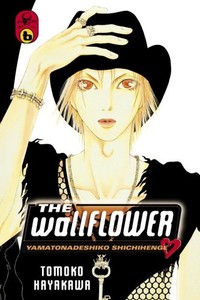Review
by Theron Martin,The Wallflower
G.novel 5-6
| Synopsis: |  |
||
Goth chick and horror movie freak Sunako runs a boarding house in her absent aunt's stead, one where four gorgeous guys have been promised free boarding by her aunt if they'll turn Sunako into a “lady.” Despite the promise, the guys and Sunako have gradually come to accept each other's identities and live in relative harmony, although outside forces constantly pull at them. This time around the shenanigans include classmate jealousy of Sunako's position, the dreaded Valentine's Day experience (for the guys), the dreaded visit by her father (for Sunako), a trip to visit Sunako's friend Yuki (who also happens to be the granddaughter of the Abominable Snow Woman), a visit to a horror movie being filmed at an abandoned school, and a look back at the time when the guys first came to live at the boarding house. |
|||
| Review: | |||
At the beginning of each chapter and the beginning and end of each volume manga-ka Tomoko Hayakawa makes various cutesy “behind the scenes” comments which seem like inane dribble about her music interests and the people who help her on the manga but are actually very revealing about how and why The Wallflower has turned out the way it does. From them one can surmise that the basic lack of plot development in the series (or plot at all, for that matter) results both from her just writing/drawing about whatever strikes her fancy at the time and from her putting only a minimal amount of effort into her work since she's constantly distracted by her music interests. The original premise is now mostly being ignored in favor of a structure which plays out like a shojo version of a TV sitcom. Oh, it's entertaining enough in this form as long as you don't mind all the silliness about how impossibly handsome these guys are supposed to be, and the total lack of depth, complexity, or involved dialogue does make it a quick and easy read. It's like eating cotton candy: light, fluffy, and tasty if you like that sort of thing but won't do much to curb your appetite. The most distinctive aspect of The Wallflower is its artistry, which uses impossibly lanky proportions on its bishonen male leads. Though the same effect is present on occasions when female characters are depicted at full size, it's less pronounced in the female designs. By this point in the series the normal depiction of Sunako has degenerated to a cute, simple chibi form with a face blank except for the mouth, though on rare occasions – about once per chapter, and generally only when the story requires her to look scary – she is drawn at full size in a finely-detailed Goth look. On those occasions Tomoko shows solid artistic talent, but the rest of the time the artistry looks lazy; Tomoko herself even admits that she's come to use the chibi Sunako as the standard because she's easier and quicker to draw that way, and one of the guest stars in volume 6 gets depicted the same way. The minimalist and often nonexistent backgrounds further contribute to the lazy look. The impression of laziness also manifests in the writing. Although the four guys are described in the “who's who” page as having distinctly different personalities, in all except the flashback story they're allowed to fall into a group action behavior mode where they are virtually interchangeable. None of them seem to have purpose and motivation beyond strutting around looking insanely pretty and getting miffed at the outrageous attention they get, but this has been done enough the other way that one can't complain about the shallow sexism of the portrayal (although complaining about the shallowness of the writing overall is another matter entirely). The only person in the series who does consistently show character is Sunako, but that and humor that is occasionally genuinely funny is not enough to carry the writing. Del Rey does another quality job here with the translation. A few rhymes and pop culture references are Americanized but the changes are fully explained in the translation notes. Small and unobtrusive (but still easily readable) translations of the sound effects accompany the originals in an ideal balance between readability and preservation of original artistic integrity. Included in both volumes are a couple of pages of explanation about Japanese honorifics, translation notes, the “who's who” page, and the aforementioned opening, closing, and periodic chapter notes from the author. Both volumes close out with a brief untranslated preview of the next volume. Volume 5 also includes a 12-page bonus story, while volume 6 contains several four-panel strips involving Tomoko's real-life exploits. Overall it's the typical good production job one would expect from Del Rey. Volumes 5 and 6 of The Wallflower aren't necessarily bad, but they are unpolished and lacking in any substance. While they can be a light and fun read, this is a title firmly aimed at shojo fangirls who like to obsess over bishonen boys. |
| Grade: | |||
|
Story : C-
Art : C-
+ Has enough energy and humor to be mildly entertaining, good English adaptation. |
|||
| discuss this in the forum (6 posts) | | |||
| Production Info: | ||
|
Full encyclopedia details about Release information about |
||